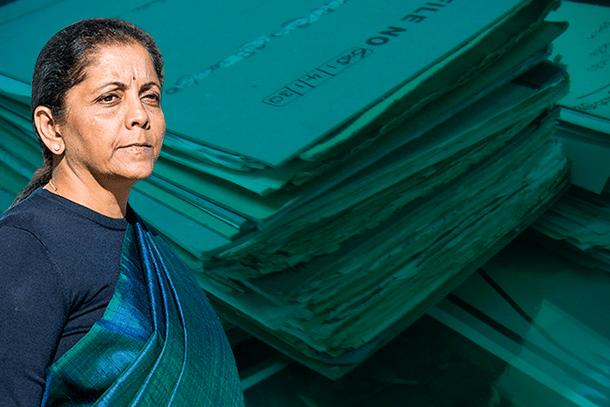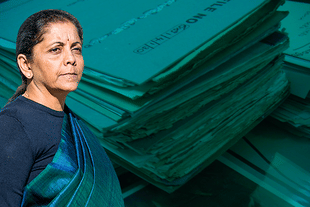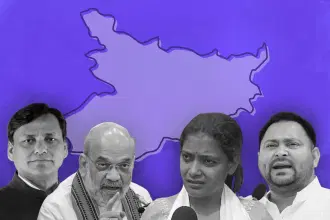Politics
End Red Tape, Roll Out Red Carpet
Minhaz Merchant
Jan 18, 2021, 12:36 PM | Updated 12:36 PM IST
Save & read from anywhere!
Bookmark stories for easy access on any device or the Swarajya app.


When Prime Minister Narendra Modi took office in May 2014, he vowed to end the red tape that for decades had choked Indian business. He pledged to instead roll out the red carpet, attract foreign investment and improve the ease of doing business in India.
More than six years later, on the eve of the 2021-22 Union Budget, it’s time to take stock.
The record is mixed.
Many archaic laws have been extinguished. The Companies Act has been simplified. Labour laws have been rationalised. The Insolvency and Bankruptcy Code (IBC) has proved a qualified success.
But with every step forward there is half-a-step backward. A welter of regulations and compliances continue to hobble business. Tax laws are changed capriciously. Higher import duties have fuelled inflation.
Despite stumbles, India’s economic ascent is inevitable. “Professional pessimists” — as Prime Minister Modi dubbed them — proliferate in India. Foreign investors are wiser. They recognise that India, regulatory warts and all, is the world’s last great economic frontier.
Markets in Europe and North America are saturated. President Xi Jinping’s China is no longer the default factory of the world. Africa is a potential marketplace of 1.2 billion people but it is a continent of 55 sovereign countries with varying jurisdictions. South America remains politically volatile.
That leaves India which possesses some formidable assets: a large, unified marketplace with rising purchasing power; a buzzing software industry; world-class tech start-ups; English as the language of business; and an Anglo-Saxon legal system.
Virtually every global company wants to be part of the post-pandemic India story. The Japanese investment bank Nomura expects India to be the world’s fastest growing economy in calendar 2021 with gross domestic product (GDP) surging by 9.9 per cent, ahead of China (9 per cent) and Singapore (7.5 per cent).
India’s GDP in the October-December 2020 quarter is likely to be flat. Positive growth should return in January-March 2021. In order to maintain the momentum, the Modi government must focus on reducing the regulatory and compliance burden that entangles companies in a bureaucratic web.
The Production Linked Incentive (PLI) scheme is one of the government’s most well-received initiatives. Foreign and domestic firms are ramping up manufacturing facilities to benefit from PLI.
As Satyakam Arya, managing director and chief executive of Daimler India Commercial Vehicles (DICV), said: “We look at India as a competitive manufacturing hub and this will happen even more with the PLI scheme announced by the government. We are waiting for the finer details. The scheme has been designed in order to push companies like us to grow globally by using India as a manufacturing hub. This scheme gives us the confidence that the government is also thinking in the same direction.”
The startup universe is particularly active. India added 12 unicorns (firms with a valuation of over $1 billion) in 2020, despite the pandemic. A Nasscom-Zinnov report projects 50 more unicorns emerging in India in 2021.
Economics is more art than science. So when economists, especially grumpy Marxist ones, say India’s economy is in a black hole from which exit is well-nigh impossible, you can be sure the opposite is true.
Depending on the ebb and flow of the pandemic, the government projects a likely 12-month contraction in GDP in 2020-21 of around 7.7 per cent.
The real future McCoy could be the April-June 2021 quarter. If real GDP growth is a modest 6 per cent in the first quarter of 2021-22, the low base of (-) 23.9 per cent in April-June 2020 will give the April-June 2021 quarter a steroid mathematical boost of 30 per cent. The surge obviously won't last, but the remaining nine months of 2021-22 should record strong growth on what could still be a fairly low base.
In totality 2021-22 could end with real GDP growth of around 10 per cent (in line with Nomura’s projection). The Indian economy would have emerged from the worst public health crisis in its history with just one abnormal year.
Normal service would be resumed in 2022-23 with growth returning to an annual trajectory of 7 per cent recorded on average during 2014-17 — if macro-economic reforms in agriculture and labour remain on track. The focus now should be on implementing the Direct Tax Code (DTC) and exhuming the Land Acquisition Bill from its resting place in the Rajya Sabha.
Judicial accountability and reforming the criminal justice system are key to making India a modern economy where legal contracts are not subjected to capricious changes in policy.
Former Finance Minister Pranab Mukherjee erred grievously in overturning the Supreme Court’s verdict on Vodafone by legislating the retrospective tax law — possibly the most egregious legislative act since Rajiv Gandhi overturned the apex court’s verdict on Shah Bano.
As Finance Minister Nirmala Sitharaman prepares to deliver her Union Budget on 1 February, she knows it is imperative to provide the economy with growth impetus.
Initiatives like the Production Linked Incentive are the red carpet Indian and foreign investors will walk the extra mile on. The Modi government must cut red tape and, to honour its 2014 pledge, roll out the red carpet.
Minhaz Merchant is an author and publisher.




